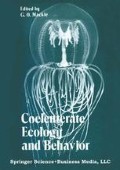Abstract
Most hydroid colonies are encased in a tubular chitinous exoskeleton, the perisarc. Hyman (1940, p. 402) observes of the perisarc that “On stems it usually forms groups of rings or annulations at definite points related to the branching... The function of these is obscure, but it is generally supposed that they lend flexibility.” Perusal of the literature and conversations vith biologists studying hydroids suggest that the annular regions on hydroid perisarc are no better understood now than in 1940. Indeed, little more is known of the perisarc itself or of the skeleton which it forms.
Access this chapter
Tax calculation will be finalised at checkout
Purchases are for personal use only
Preview
Unable to display preview. Download preview PDF.
References
Blanquet, R., 1972. Structural and chemical aspects of the podocyst cuticle of the scyphozoan medusa, Chrysaora quinquecirrha. Biol. Bull., 142: 1–10.
Chapman, D. M., 1968. Structure, histochemistry and formation of the podocyst and cuticle of Aurelia aurita. J. Mar. Biol. Ass. U. K., 48: 187–208.
Hyman, L. H., 1940. The Invertebrates Vol. 1. McGraw-Hill, New York, 726 pp.
Knight, D. P., 1968. Cellular basis for quinone tanning of the perisarc in the thecate hydroid Campanularia (= Obelia) flexuosa Hinks. Nature, 218: 584–586.
Knight, D. P., 1970. Sclerotization of the perisarc of the calyptoblastic hydroid, Laomedea flexuosa 1. The identification and localization of dopamine in the hydroid. Tissue & Cell, 2: 467–477.
Knight, D. P., 1971. Sclerotization of the perisarc of the calyptoblastic hydroid, Laomedea flexuosa 2. Histochemical demonstration of phenol oxidase and attempted demonstration of peroxidase. Tissue & Cell, 3: 57–64.
Koehl, M. A. R., 1976. Mechanical design in sea anemones. This volume.
Manton, S. M., 1941. On the hydrorhiza and claspers of the hydroid Myriothela cocksi (Vigurs). J. Mar. Biol. Ass. U. K. 25: 143–150.
Neville, A. C., 1975. Biology of the Arthropod Cuticle. Springer-Verlag, Berlin, 448 pp.
Svoboda, A. 1976. The orientation of Aglaophenia fans to current in laboratory conditions (Hydrozoa, Cnidaria). This volume
Wainwright, S. A., W. D. Biggs, J. D. Currey, and J. M. Gosline. 1976. Mechanical Design in Organisms. John Wiley & Sons, New York, 423 pp.
Author information
Authors and Affiliations
Editor information
Editors and Affiliations
Rights and permissions
Copyright information
© 1976 Springer Science+Business Media New York
About this chapter
Cite this chapter
Murdock, G.R. (1976). Hydroid Skeletons and Fluid Flow. In: Mackie, G.O. (eds) Coelenterate Ecology and Behavior. Springer, Boston, MA. https://doi.org/10.1007/978-1-4757-9724-4_4
Download citation
DOI: https://doi.org/10.1007/978-1-4757-9724-4_4
Publisher Name: Springer, Boston, MA
Print ISBN: 978-1-4757-9726-8
Online ISBN: 978-1-4757-9724-4
eBook Packages: Springer Book Archive

